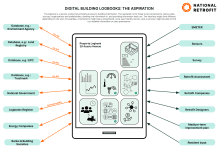Matt Richards, built environment expert and partner at Ridge and Partners, discusses the obstacles construction professionals face when retrofitting the UK’s commercial buildings to reduce emissions and what can be done to prevent stalling the race to net zero
It’s true that oil and gas corporations contribute a large proportion of the 367m tonnes of CO2 emitted by the UK every year, but essential changes need to be adopted in other sectors too.
For instance, with the government’s 2050 net zero deadline approaching fast, retrofitting the UK’s commercial buildings will be vital if the country is to meet this target.
Despite this, The Role of Retrofitting our Non-Domestic Buildings in the Race to Net Zero found that although 76% of organisations say they are working to achieve net zero, fewer than one in four are considering how to make their premises more environmentally sustainable.
The report continues to uncover a multitude of factors which are preventing a retrofit revolution.
What’s preventing a retrofit revolution in the UK?
One primary issue we uncovered in our report is the position occupied by the boards. 55% of the facilities and property managers we interviewed say their boards fail to acknowledge the need to retrofit as a feature of their net zero strategy.
Even more concerning than that is the role of building heads in decision-making. For instance, 23% of those in charge of these organisations’ buildings are not involved in any net zero planning at all.
Similarly, the majority don’t have sight of their company’s five year plan.
Those who are involved in net zero planning often underestimate the carbon pollution produced by buildings and the importance of reducing this.
In fact, 86% of organisations are not considering retrofitting to enhance their energy efficiency.
There is also an inaccurate view of how much of the UK’s current commercial building stock will still be in use by 2050. More than a third mistakenly anticipate that less than 39% of the UK’s existing non-domestic stock will still be in use in 2050, although that figure will actually be closer to 70%.
With so many organisations erroneously assuming they will be in new buildings when the time comes, it is easy to see how retrofitting is not on so many agendas. The UK will not meet net zero if organisations continue on this path, tolerating energy-inefficient buildings which they see no need to retrofit.
The five key areas that will help in retrofitting the UK’s commercial buildings
-
Education
A lack of knowledge is leading to misconceptions among boards. For instance, 24% underestimate retrofitting’s impact on their carbon footprint. And 45% believe if energy from the grid is carbon neutral then they don’t need to worry about their own energy efficiency.
Technologies like heat pumps remain underrated for retrofit programs, despite their potential to reduce emissions by up to 300% compared to gas boilers.
2. Involvement
Boards also need to recognise and utilise the expertise of their facilities and property heads. They need to involve them in their strategic plans and give them an opportunity to input into them.
3. Budgeting
Retrofit programmes require significant spending, which cannot be found in a building’s day-to-day budget. Yet 54% told us they set their building budgets based on the previous year.
This approach doesn’t accommodate inflation or even energy price hikes, let alone retrofit programs. A new approach is required to the budgeting of current buildings is clearly needed.
4. Expert Support
Organisations are uncertain about how to achieve net zero, unsure about retrofitting vs. new build options, and are struggling to evaluate possibilities.
For instance, many were unsure how to weigh up the captured carbon in a new build. They need external support to navigate the complexities, make business cases, and choose appropriate solutions.
5. Incentives
There is a serious lack of Government incentives for energy-efficient buildings. Our interviewees felt things such as the treatment of VAT for retrofit programmes need to be addressed to put it on a more level playing field with new build.
The practicalities of retrofitting
Even if these issues are addressed, and everyone in an organisation agrees that a retrofit project should be a part of their net zero strategies, there are further barriers to consider.
31% of the facilities heads we surveyed agreed that the biggest challenge to retrofitting is being able to deliver it without causing disruption to operations. Because of this, 48% believe it is cheaper to build new rather than retrofit an existing building to comply with net zero.
Whilst potential disruption is certainly a challenge to overcome, the long-term benefits of a retrofit project will outweigh short-term interruptions to business. By properly planning with multi-disciplinary consultant teams in place, plans can be made to minimise disruption and ensure organisations can continue to operate as normal during a retrofit project.

















